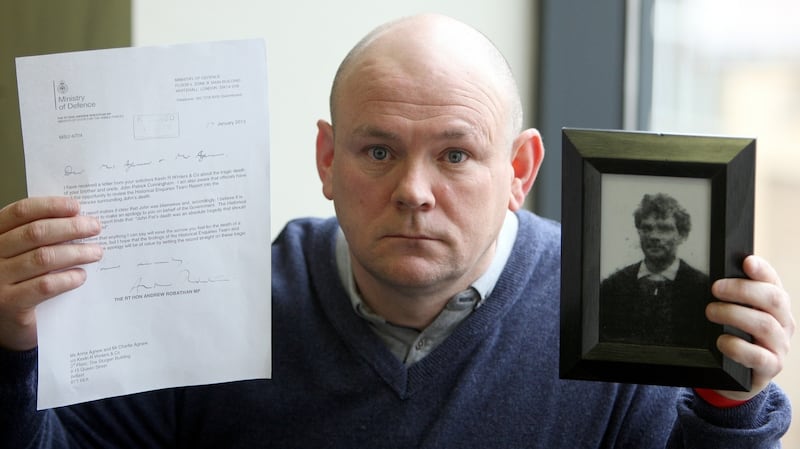The field in which John Pat Cunningham died is as unremarkable as any in Ireland. Standing at the gate, outside the village of Benburb, Co Tyrone, the grey drizzle lends a heaviness to the silence settled over the pasture land and the distant hills.
There is no marker, nothing to indicate what took place here more than 40 years ago – events that go to the heart of the ongoing debate over how to address the past in Northern Ireland, and which continue to scar its present.
On June 15th, 1974, it was into this field that Cunningham – a 27-year-old vulnerable adult who was frightened of soldiers – fled when he saw two British army Land Rovers approaching.
The patrol halted, and two soldiers pursued him, shouting at him to stop and to put his hands up. He kept running. Five shots were fired. He died where he fell.
Today one of those soldiers, Dennis Hutchings – a 76-year-old former staff sergeant in the Life Guards Regiment who was in command of the patrol – is facing trial for the attempted murder of Cunningham.
He is the first former soldier to have been brought before the courts following a so-called “legacy” investigation into a Troubles-era killing.
Two Parachute Regiment soldiers have been charged in connection with the death of Official IRA leader Joe McCann in Belfast in 1972, while prosecutions are expected this year about the Bloody Sunday deaths.
Unable to vote
Having joined the British army in 1959, aged 19, Hutchings was sent to Northern Ireland at the outbreak of the Troubles a decade later. He remembers being surprised at finding out – while searching a house in east Belfast – that the residents were unable to vote.
“They told me they were Catholic people, and they didn’t have a vote, and the person who owned the house, who was a Protestant, he had their vote, which I found absolutely unbelievable. All the soldiers did,” said Hutchings.
He describes the British army’s role as, initially, “protecting the Catholics from the Protestants”.
“The next tour was protecting Protestants from Catholics, and after that we were in the middle. We lost, I think, about three or four of the lads during the tours. We lost one two weeks before the incident with John Pat Cunningham.”
In fact, according to the official list from the British ministry of defence, only one member of the Life Guards, Lance Corporal of Horse Leonard Durber, was killed during Operation Banner in Northern Ireland. He died in hospital in London in February 1973, more than a year before Cunningham and five months after being injured in rioting in Belfast.
An absolute tragedy
“John Pat, like most other people who lost their lives in that period of time over here, had become a statistic,” says Charlie Agnew, who was four when his uncle was killed. He remembers a big, strong man who used to lift him and throw him up into the air.

In 2013 a report by the North’s Historical Enquiries Team (HET) found that Cunningham posed no threat, and his death was “an absolute tragedy”.
It led to an apology from the British government. “The apology was massive,” says Agnew. “It was open and direct.”
It also said his uncle was innocent, and that his killing should not have happened. “It was also a very comforting thing for my family, because it took the attribution of blame and guilt away, and I have to acknowledge the state for being brave enough to give us that.”
Today, however, Hutchings is angry. “I’ve been cleared twice on this incident. “Once in 1975 when it was investigated by the director of public prosecutions (DPP), and then it was reinvestigated again by the HET and they couldn’t find any further evidence.”
Patrol members at the time were briefly interviewed under caution, Hutchings for 20 minutes. The DPP directed that there should be no prosecutions.
The HET reported that the soldiers who fired had “declined to provide an account of what happened”, and there were no grounds to arrest or further interview them under caution, and therefore no new lines of inquiry to progress.
Full facts
“Although the HET cannot be critical of them for exercising their legal rights, the consequence of their decisions has resulted in the full facts of the case about John Pat’s death never being established,” the report stated.
“I know that John Pat Cunningham was given every opportunity to stop. There were shouts from various members of the patrol for him to stop, stand still, and he didn’t, he ignored it,” says Hutchings.
“It’s a case of our government [in Britain] being terrified of upsetting Sinn Féin. The Northern Ireland government and the legacy department of the PSNI is hounding servicemen because they’re easier than chasing terrorists.”
Four decades on, Agnew believes his uncle is now being remembered. “Sometimes it’s a bit surreal because you’re coming home from work and somebody you’ve never heard of is sitting in the House of Commons talking about your family.
“All of a sudden he’s not a number, shot in a field and forgotten about. John Pat Cunningham is no longer just a statistic, the village idiot. He’s somebody, and he’s somebody very prominent.”









